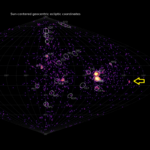Greetings yet again all,
Finally, a day I did not have to commute or work and since the moon was out of the pre-dawn sky, I figured it was time to revisit trusty Matanzas Inlet, Florida (MI) for a true dark sky meteor watch. And I was not disappointed!
I got there just before 0430 EDT and was greeted by a pitch black sky blazing with the stars of the winter constellations and a lovely sea breeze on top of it. Before I get to the data, here are a few general observations from this memorable morning:
– it was sad and tragic to travel south on the “beach road” (A1A) below Crescent Beach as the almost entire 4.2 miles of highway down to Matanzas Inlet was piled high on either side of the road with folks furniture, mattresses, dressers, sofas, cabinets and tons of drywall – all ruined by the storm surge from Hurricane Matthew.
– our trusty parking lot observing site at the inlet was devoid of cars because Hurricane Matthew destroyed the boardwalk down to the inlet itself. No more flounder fishermen to share the morning with…:o(.
– despite a brisk easterly sea breeze, the post Matthew flock of mosquitoes found me and quickly distracted me from an otherwise perfect observing morning.
– Almost from the time I arrived, there was a sensational display of Zodiacal Light rising up from the eastern horizon through Leo and into Cancer, with a yellow diamond stud embedded in the middle of it (Jupiter)! It was an amazing sight that grew steadily brighter and by the time I wrapped up the two hour session, had actually begun to light up the sea spray around it in a ghostly glow that had me thinking I was actually in The Twilight Zone…;o). I mean, who ever heard of the Zodiacal Light virtually casting shadows!!?
The meteor activity was amazing as well as I counted a total of 65 meteors of all types in two hours under the razor sharp skies. The first hour (0420 – 0520 EDT) had an insane number of 36 meteors flash by, many of them too faint for me to ever have been able to see from the “meteor roof” back home. That kind of activity is why I risk the mosquitoes and the “no-see-um” gnats down at MI.
The second hour (0520-0620 EDT) saw slightly fewer numbers of meteors (29), but they got much brighter: I had a stunning -3 blue-white sporadic near-fireball light up and split the zenith, then later a lovely yellow, -2 late Orionid zipped through Cancer heading northeast. What a meteor morning it twas!!
Here’s the data:
Observed for radiants:
ORI: Orionids
AND: Andromedids
STA: Southern Taurids
EGE: epsilon Geminids
LMI: Leonis Minorids
SPO: sporadics
Date: Oct., 28/29, 2016. Observer: Paul Jones, Location: north bank of Matanzas Inlet, Florida, 18 miles south of St. Augustine, Florida, Lat: 29.75 N, Long:81.24W, LM: 6.5, sky conditions: clear, Facing: west.
0420 – 0520 EDT (0820 – 0920 UT), Teff: 1 hour, no breaks
13 ORI: +1, +2(3), +3(4), +4(3), +5(2)
4 STA: +3(3), +4
1 EGE: +3
2 LMI: 0, +2
16 SPO: +1(3), +2, +3(6), +4(5), +5
36 total meteors
2 of the 13 ORIs, 1 of the LMIs and 2 SPOs left visible trains, most common colors were bluish white and yellow in the brighter ones.
0520 – 0620 EDT (0920 – 1020 UT), Teff: 1 hour, no breaks
10 ORI: -2, +2, +3(3), +4(2), +5(3)
2 STA: +1, +2
1 LMI: +1
16 SPO: -3, +1(2), +2(5), +3(2), +4(5), +5
29 total meteors
1 of the 10 ORIs, 1 of the LMIs and 2 SPOs left visible trains, most common colors were bluish white and yellow in the brighter ones.
The post maximum Orionids show no signs of quitting yet, they’re like the Energizer Bunny of the meteor showers…;o). It never ceases to amaze me the difference a truly dark sky makes on seeing faint meteors. Even the tiny little fourth and fifth magnitude meteors are easy to spot and the bright ones are even more showy than they otherwise would be. As I write this, the skies are deep crystal blue and that can only mean one thing: I’ll be out there in the morning once again, come 0430 EDT!!
More later, Paul




